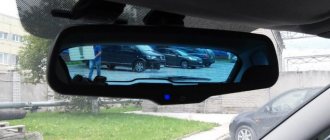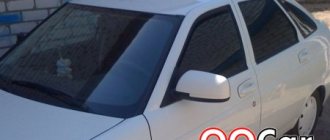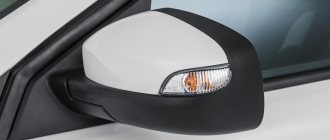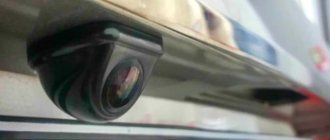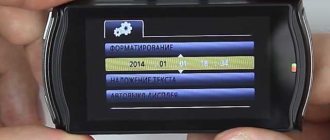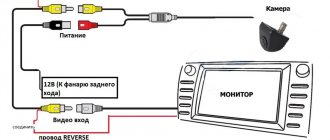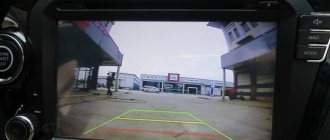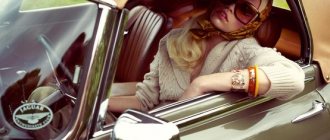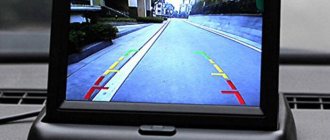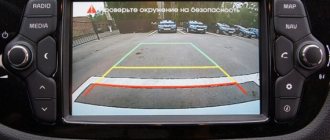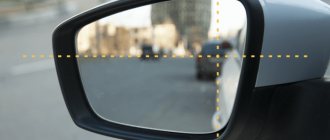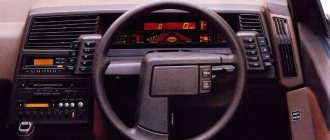Rear view mirror device
Frame
Most often it is rectangular or trapezoidal in shape with rounded edges, less often triangular or round.
Reflective element
Usually this is extra-strong glass, on top of which a layer of reflective substance is applied, and then another layer of a special protective coating. This coating protects the mirror from scratches, chips, and abrasions, which directly affects the quality of reflection and, accordingly, safety. The reflective layer should not distort the shape of objects, color, or change the distance to the reflected objects.
The reflective layer can be different:
- A simple mirror - on which there is no special treatment. The disadvantage of such mirrors is the appearance of blinding glare from the bright sun, wet road surface, and car headlights.
- Anti-reflective colorless coating reduces glare.
- Anti-reflective color coating not only reduces glare, but also improves visibility, clarity and contrast of objects by changing the spectrum of reflected light.
Fastening
Allows you to securely fix the mirror at the installation site. The rear view mirror mount must be able to withstand active vibration and shaking while driving on uneven roads and defects in the road.
Mirror position adjustment device
With its help, the position of the mirror is adjusted to achieve the required viewing angle.
Folding mechanism
This mechanism is installed on the side mirrors. Allows you to fold the mirrors to reduce the size of the car. It can be mechanical or electrical. Folding the mirror must be done with sufficient force so that the mirror does not fold when driving at high speed or when the vehicle shakes.
A mirror adjustment technique for experienced drivers that completely eliminates blind spots
You need to understand that there are many techniques for adjusting car mirrors. They all have the right to life and are considered true in their own way. It is simply impossible to describe any single, ideal method of adjustment, against which all others pale in comparison.
Experienced drivers believe that side mirrors are not designed to look at the horizon. It's simple: they should show whether there is a car nearby or not.
Tips for setting up reflectors on middle-class cars.
- A car moving in the adjacent lane is clearly visible in the interior mirror, and is fully visible in the right side reflector.
- You can see the door handles and the side of your car by simply turning your head a few degrees.
- If a neighboring car disappears from view in the interior mirror, it must appear in the side mirror. If it is not reflected in the side, then it becomes visible directly through the glass. Thus, the driver understands whether he can change lanes or not.
Premium car customization.
- The side mirrors are initially large; the palm of an adult man does not cover their glass. They make it possible to control the entire roadside and see the doors of your car.
- When reversing, the side reflectors automatically fold and lower, improving visibility.
Budget class (domestic “classics” and others).
- It is recommended to reinforce the glass of the side mirrors with clamps to prevent them from falling out or moving relative to the body.
- The window in old-style cars takes away half of the useful view - this must be remembered.
- The car in the next lane is visible in the side mirror, but you can see your car only after turning your head at a large angle.
- The central reflector also shows the edge of a car moving nearby. When the car is not visible in the cabin reflector, it is controlled by the side mirror, disappears from the side reflector and becomes visible through the glass.
Try to stay in sight, don’t forget about the headlights, warn neighboring drivers about the maneuver, and don’t be lazy to turn your head while looking for blind spots.
What types of rear view mirrors are there?
There are several types of car rear view mirrors. They differ in installation location, type of optical element, shape, etc.
By location
- Internal (cabin) . They are located inside the cabin and are mounted on the windshield using a bracket. As standard they have an elongated rectangular shape with rounded edges. The tilt angle is adjusted manually.
- External (lateral) . These are paired mirrors located outside on the car body on the left and right. On right-hand drive cars in Russia, an additional side mirror is often installed on the hood to improve visibility.
By type of optical element
- flat;
- panoramic (spherical);
- multi-sectional (with variable curvature).
Flat mirror
A flat rear view mirror provides a minimal viewing angle, but transmits the image of objects and the distance to them without distortion. The flat mirror conveys the actual traffic situation, which makes it easier for the driver to make decisions.
It has a switch mode to a non-dazzle position, which is very convenient to use in the dark. In such a mirror, the reflective layer changes its position depending on the position of the switch. In the “day” position, objects are reflected more brightly from the mirror layer. In the “night” position, a less bright reflection occurs. Switching can be done manually or on some mirrors - automatically when the light sensors are triggered.
Panoramic rear view mirror
Installed inside the car interior. It has a spherical element of large radius and greater length, unlike a conventional standard flat mirror. The use of spherical mirrors allows you to increase the viewing angle to 160 degrees on both sides and reduce the field of “dead” zones. But such mirrors somewhat distort the shape of objects and “increase” the distance to them, which can mislead the driver.
One of the main requirements for a panoramic mirror is uniformity of curvature, which is responsible for minimal distortion of reflected objects and the distance to them. Poor-quality panoramic mirrors can pose the danger of significantly distorting the reflection of objects, causing the effect of “double reflection” and “increasing” the distance to objects.
All this can negatively affect the assessment of a safe distance on the road and the choice of the wrong decision. It is better not to use panoramic mirrors for a novice driver. Yes, and a driver with extensive driving experience needs some time to get used to changes in the reflection. When choosing a panoramic mirror, you need to take into account the distance to the sun visors: a mirror that is too long will not allow them to be lowered.
You can purchase an overhead panoramic mirror that attaches to the standard interior rearview mirror. One of the disadvantages of such mirrors is the lack of ability to switch to a non-dazzle position, which is absent in panoramic mirrors. In this case, it is better to give preference to a panoramic mirror with special anti-dazzle tinting.
The overhead panoramic mirror should be lightweight since it is mounted on a regular mirror glued to the windshield. If the weight increases significantly, it may come off due to vibration while the car is moving.
Multi-section rear view mirror
They consist of several mirror elements of various types. Allows you to eliminate “dead” viewing zones as much as possible. They combine a section of a simple mirror that transmits an image without distortion with additional spherical sections that allow you to see objects located in the “dead” zone.
Spherical areas greatly distort the shape and distance to the object, but carry the most important information about the fact of the presence of this object or object. A section of a conventional flat mirror allows one to adequately estimate the distance. The work of these two mirrors together allows the driver to significantly increase the viewing angle and make the right decision in a traffic situation.
How to learn to feel a car
A few simple exercises will help you learn how to feel the dimensions of a car. Novice drivers should practice spatial orientation skills on a closed race track. It is for this purpose that instructors separate small areas with flags and force students to drive into a conditional box. We suggest watching a video about how to learn to sense dimensions, and then complete several lessons.
Lesson 1. Visualization
Mentally draw the position of your car relative to the walls of the box, get out of the vehicle and compare the picture presented with the real one. As a rule, it seems to beginners that the edges of the car are much closer to the walls of a conventional garage than they actually are.
Lesson 2. Beacons
Install an antenna at the extreme point of the hood; it will help you understand where the car body ends. At any time you can stop the car, get out of the car and see how close the obstacle is. After this, it will become clear how to do it correctly in a car, how to evaluate the distance and your own dimensions.
Lesson 3. Marking lines
If you are a beginner, to get a feel for the car, mark six lines on the asphalt with chalk or spray paint that:
cross the front and rear wheels; continue the left and right axes; outline the rear and front bumpers.
The intersection points of the wheels with the front dashboard can be marked with colored paper or tape on the windshield. The marks will give an idea of the expected trajectory of movement. Thus, you will learn to determine the place on the road along which the car’s wheels will pass. Over time, the tags will no longer be needed; a chain of reactions will be developed in the brain.
Similarly, you can mark the intersection lines of the front and rear bumpers, front and rear wheels. The markings will make it easier to determine and feel the size and trajectory of the car.
Lesson 4. Getting hit by wheels
Place a small piece of cardboard on the road and deliberately try to run over it with each wheel in turn. This exercise will help you develop your sense of wheel line. Practice not only moving forward, but also reversing.
Lesson 5. Snake
Place barriers on the roadway and try to go around the obstacles without hitting them. Lighthouses can be marked with flags, cones, or ordinary plastic bottles.
Try to drive as close to the beacons as possible. Start with simple exercises, and over time make the tasks more difficult for yourself: place the flags closer together and try to guide the car closely between obstacles; "eight" and "snake".
The main advice on how to get used to the dimensions of the car is to practice as much as possible. You can also watch the video, which will help you get acquainted more clearly https://www.youtube.com/watch?v=l4EiBC8tgP8. Ask an experienced driver or instructor for additional training with you on the site.
Skills are acquired through driving. You will learn to intuitively sense the correct distance to obstacles with high accuracy. With experience, you will understand how to navigate the mirrors in the car, how to feel the car.
Rear view mirror with monitor
These are modern, technically sophisticated rear view mirrors that have many useful functions and are discreet. They can be installed instead of the standard rear view mirror or attached to it with double-sided tape, or simply superimposed.
It is an LED display that displays information from the rear view camera and parking sensors. The display can be of different sizes: from very small to significant 9 inches. This display conveys important information to the driver, making it easier to park in tight spaces, reverse and improve road safety.
There are more complex models of rear-view mirrors with monitors that have the ability to connect a front camera, video recorder, memory cards, touch control, radar detector, GPS navigator.
When choosing a mirror with a monitor, you should pay attention to the following criteria:
- Car model . Typically, such mirrors are universal and can be purchased for any car, but there are special displays produced for specific car brands.
- Price . Depending on the set of built-in functions, the price of mirrors can make a huge difference.
- Monitor dimensions . A larger screen will convey more information, but may significantly reduce the view of the road through the windshield.
- Fastening . Monitors can be attached to the windshield using a suction cup, double-sided tape, or placed on a standard rearview mirror.
How to properly glue a car mirror to the windshield
To achieve a strong and reliable fixation, it is important to learn how to use the adhesive correctly:
It is best to fix the mirror in the center of the windshield. To correctly select the location of this element, you need to apply strokes with a marker. It is recommended to do this outside. Thanks to this, you will be able to immediately glue the mirror correctly and avoid the need to change its location. Be sure to get rid of any remaining glue. To do this, it is recommended to use a stationery knife. To clean the metal of the bracket from foreign objects, it is recommended to preheat it. This can be done with a hairdryer. Thanks to this simple manipulation, the glue will be removed much easier. Use fine sandpaper to sand the glass in the gluing area. It is enough to lightly rub the surfaces. This will help increase the adhesion of the parts. Wipe the glass and holder with a degreaser. To do this, it is not enough to treat the surface with a soft cloth soaked in acetone. To achieve good results, one rag should be soaked in acetone and applied to the glass to dissolve the grease, and the second should be used to remove any remaining dirt. Remove the metal fastener. It is recommended to move it down. If this is not possible, it is necessary to think in advance about support for the mirror while the glue hardens. Start the gluing process. This is done after the surfaces have dried. Before using the substance, you should carefully study the instructions. You should pay attention to the areas where the adhesive and activator are applied.
The duration of gluing is of no small importance. Fix the mirror for the polymerization period. Good glue is not able to harden in a few minutes. Therefore, while drying, the car mirror needs to be securely fixed.
It is recommended to place a strong magnet on the outside of the windshield. If it is not there, it is permissible to use tape or plasticine. However, subsequently there will be a need for purification from excipients.
Characteristics and types of cork glue, instructions for use
Additional exterior mirrors
Additional exterior rear view mirrors are used mainly on public transport, trucks and special equipment. They are designed to minimize dead spots. Most often, such mirrors have a strong curvature, due to which they increase the viewing angle, but greatly distort the shape and distance to objects, so it becomes problematic to adequately estimate the distance.
Sometimes additional spherical mirrors are installed on the main rear-view mirrors. This can be dangerous, since it significantly reduces the viewing area through the main mirror, which carries information about objects located near the car.
Additional functionality of panoramic mirrors
Manufacturers are working very actively on the functionality of interior reflective elements. Today you can buy mirrors that have:
- Anti-glare coating. Depending on the type of coating, the mirror gives off a blue, golden, or sometimes other color. The coating itself prevents the driver from being blinded by light from headlights, city lights, architectural lighting and other things;
- With a darkened image. Mirrors with such an image are most optimal for installation in cars with transparent glass;
- With a brightened image. Suitable for installation in cars with tinted glass.
Based on functionality, mirrors are divided into the following groups:
- Without any additional functions. The most common elements that are included in the standard equipment of the car;
- With built-in instruments and electronics. In the vast majority of cases, there is only one device - an electronic watch. Sometimes very important and useful things are built in: recorder, monitor, backlight, bell indicator;
- Double mirror. Next to the main mirror there may be a second smaller one. As a rule, it is flat, but there are models of interior mirrors with an additional spherical element.
Mirrors without functionality are in greatest demand, since you have to pay a considerable amount for all the additional little things. Drivers often buy mirrors with a built-in video recorder and display. Exotic functions: telemetry, gyroscope, accelerometer.
How to properly adjust the rear view mirror
In order to have maximum control over the constantly changing road situation, it is necessary to properly adjust the rear view mirrors. The main rule for adjusting mirrors is to reduce the volume of “dead” spots that the driver cannot see. Because if the driver does not see any objects falling into the car’s “dead” zones, he believes that they are not there. Such incorrect data can lead to an incorrect assessment of the traffic situation and making the wrong decision, which may result in an accident. Therefore, everyone is trying to reduce “dead” zones as much as possible.
There are several ways to do this:
- Correctly adjust the standard rear view mirrors;
- retrofit the car with additional mirrors;
- use cameras that transmit images of the space around the car to the screen.
Adjusting rear view mirrors
You cannot adjust the mirrors while the car is moving. The mirrors are adjusted before driving.
To do this you need:
- sit in the driver's seat;
- adjust the seat and steering column;
- take the correct landing;
- adjust the mirrors.
Setting the interior mirror:
- The center line of the mirror should coincide with the center line of the rear window of the car. The entire rear mirror should be visible through the interior rearview mirror.
Side mirror adjustment:
- you need to take the right position, look in the left mirror. It should only show the door handles and the rear fender of the car.
- Look in the right mirror and adjust it so that it shows the right rear fender.
In correctly adjusted side mirrors, there is practically no reflection of the car.
Rear view mirror care
Rear view mirrors must always be clean. They must be washed and dried periodically to avoid streaks. Dried raindrops on exterior mirrors quickly become covered with a layer of dust, in which case, when exposed to sunlight, they completely lose their ability to reflect objects. The driver becomes practically “blind” on the road, this is very dangerous.
When it rains, water gets on the mirrors, which significantly reduces their reflective function. In this case, you must either periodically wipe the mirrors or turn on their heating so that the drops dry. In winter, when the interior and side mirrors freeze from frost, you must first warm them up, clear them of frost, and only then start driving.
Datsun 240z (aka Nissan S30)
In the search for the optimal location of exterior mirrors, we found this option - on the wings.
This scheme was considered more advanced in terms of safety: the driver has fewer reasons to look away to the sides. But it all came down to the complexity and inconvenience of the mechanisms for adjusting the mirrors. This scheme lasted the longest in Japan - until the 1980s. In the photo: Datsun 240z (aka Nissan S30), produced until 1978. In the search for the optimal location of exterior mirrors, we found this option - on the wings. This scheme was considered more advanced in terms of safety: the driver has fewer reasons to look away to the sides. But it all came down to the complexity and inconvenience of the mechanisms for adjusting the mirrors. This scheme lasted the longest in Japan - until the 1980s. In the photo: Datsun 240z (aka Nissan S30), produced until 1978.
Electric adjustment of side mirrors appeared in 1982, but for a long time many manufacturers believed that mechanics were simpler and better. Today, as you know, even on inexpensive models, mirrors can fold/unfold independently. For many owners, this function is still unnecessary, but they no longer have to choose.
In addition, the side mirrors acquired autonomous heating and built-in turn signal repeaters, gradually ceasing to be a simple and repairable thing. Today it is a rather complex optical-electrical unit. On some advanced models it is supplemented by video cameras that transmit a picture of what is happening to the screen located on the instrument panel.
Main characteristics of panoramic mirrors
Panoramic mirrors differ from ordinary ones in that they are given a spherical shape. If you decide to compare a regular flat mirror and a spherical one, you will immediately notice that with the same dimensions (say, 240 millimeters wide), they have a huge difference in viewing angles. The sphericity of interior mirrors is clearly regulated - the curvature cannot exceed 1200 millimeters. If the curvature is greater, the reflection will be distorted and the driver will not be able to correctly determine the distance to the reflected object.
Panoramic mirrors are no different in design from those that were already installed in the car or can be found in a spare parts store:
- Frame;
- The actual optical element;
- Fasteners
One difference from a standard mirror is immediately noticeable – the size. The dimension can be as follows:
- From 240 to 280 millimeters. Such mirrors are called standard or small. Most cars have them as standard;
- From 300 to 360 millimeters. Such elements are already larger than standard ones. They are ideal for installation in passenger vehicles;
- From 400 to 450 millimeters. The best option for large vehicles, such as SUVs, minibuses and others.
Most mirrors are a reflective element, which is fixed in a plastic case with fasteners on it. Standard mirrors usually do not have additional functions. But the analogue, which will soon become a replacement for a standard part, is much more interesting.
